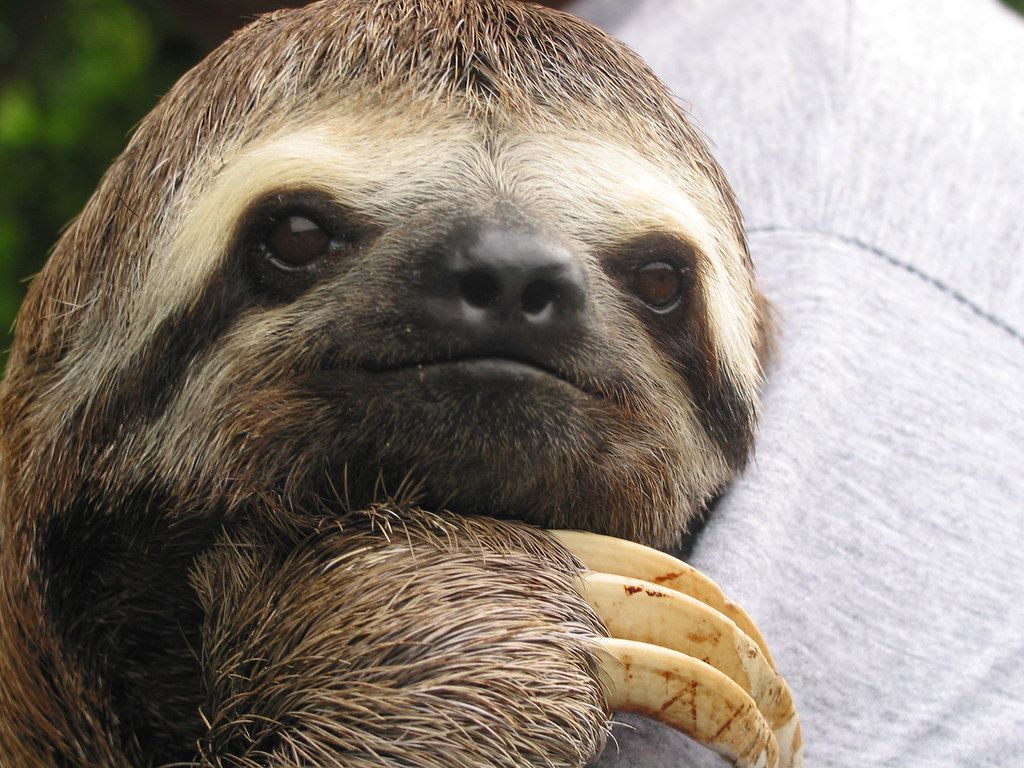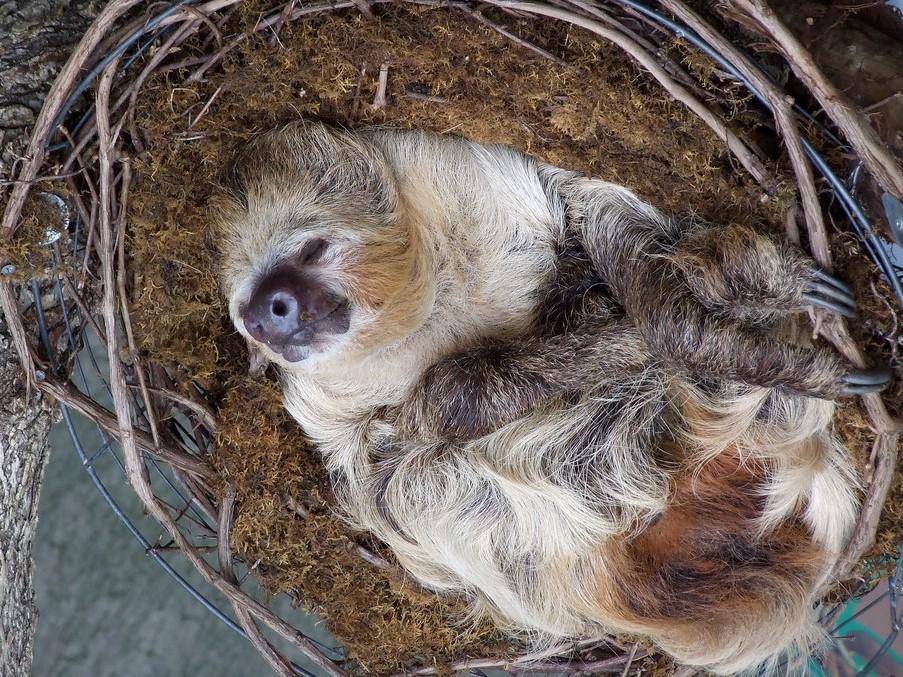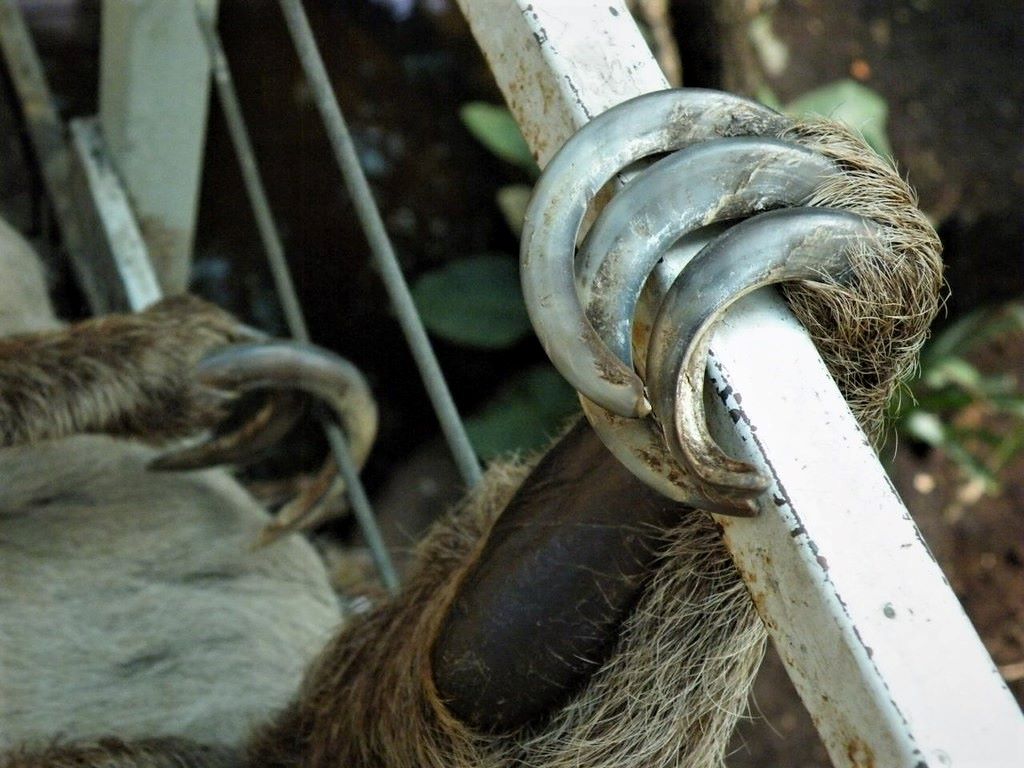
Have you ever seen a sloth? Ever wondered why are sloths slow? Since we moved to Costa Rica, I’ve learned a bunch of funny sloth facts that have made me LOL… oh ya, and learn a bunch, too. These animals are so impressive and have evolved from the size of elephants!
These 50 sloth facts for kids answer questions like why are sloths slow, what do sloths eat, even how you can adopt a sloth to help protect them and their habitat. Read on for fun facts about sloths and share them with your friends! We have lots to learn about these adorable creatures, including how to breathe while hanging upside down all day!
Funny Sloth Facts
Did you know that sloths can NOT walk?! They actually can move up to three times faster when they swim vs on land, which isn’t saying much.
Speaking of sloths swimming, sloths can hold their breath for an impressive 40 minutes.
The modern sloth is usually around the size of a medium-sized dog, but did you know….
Ancient sloths of years ago, known as Megatherium, could grow as large as an Asian elephant!
Sloths have extra vertebrae at the base of their neck that allows them to turn their head on a 270°.
Sloths obtain an almost 360° view of their surroundings, which proves to be a highly beneficial defensive mechanism and super duper funny!
BABY SLOTHS!!!! Sloths try to reproduce once a year but sometimes don’t have enough energy to find a partner! How hilarious is that?!
The mommy sloth is pregnant for 11.5 months. That is longer than a human!
The mom sloth gives birth to only one baby at a time, just like most of our moms do.
When a mom gives birth, her job is not done yet! The baby sloth clings on to her mother for a few weeks and stays by her side for about four years.
Fun Facts about Sloths
Why do sloths move so slow?! The sloth’s body allows it to conserve energy, moving slower than any animal on the planet!
Sloths usually travel no more than 125 feet (38 meters) in a single day, and on the rare occasion that they find themselves at ground level (when they poop! See below…), they crawl only 1 foot (30 cm) per minute.
Sloths can move very fast when being threatened or hunted about 2 meters per min. Or 3 meters on the ground level per min.
Sloths poop once a week which makes them have serious constipation sometimes!
Sloths have to go so on the ground to make their poop dreams happen, making them an easy target for a predator.
When a sloth goes down on ground level they do a ‘poo dance’ and dig a small hole to put their treasures in. I’ve seen it happen and it is as funny as you think it is!
The facial structure of a sloth gives the appearance that it is constantly smiling, which is why we’re all obsessed with them! But their face looks like its smiling even if it is experiencing pain, stress or anxiety!
When sloths are used as a photo prop for wildlife selfies, tourists may accidentally confuse this feature for happiness or contentment and cause undue stress to the animal. Actually, in 2019, Costa Rica launched a campaign discouraging tourists from taking “cruel or inappropriate selfies” with animals. Learn more about Costa Rica’s initiative here.
Though captive sloths have been known to sleep 15 to 20 hours a day, wild sloths will usually only snooze for 10 hours.
Where Do Sloths Live?
Wild sloths live in trees most of their lives, but sloths are actually among the best-adapted creatures in the rainforest of Central and South America. Though they’ve adopted for tree-hugging life, sometimes sloths fall out of trees too!
Sloths are built perfectly for life in the trees because of their adaptive traits, such as arms that are longer than their legs and curved feet for grasping branches and specialized claws for hooking on, as well as flexible bone structure allowing for flexibility.
A sloth’s fur actually serves as a self-contained ecological community supporting colonies of moths and algae. Like every sloth is carrying around a little world of their own!
Recently, scientists took samples of fungus from sloth hairs and found that some were adept at fighting parasites, bacteria and even human cancer cells!
Why Are Sloth Slow?

Sloth Diet
The sloth diet is super healthy! So what do sloth eat, exactly? Sloths are herbivores meaning they do not eat other animals – just lots of flower buds, leafy, green stuff and tender shoots of trees. You know, the stuff our parents are always telling us to eat!
Sloths have a multi-compartment stomach (like FOUR parts!) that allows them to effectively digest the tough cellulose vegetation they eat.
Sloths take over 30 days to digest one leaf! Talk about taking your time…
Do you mix up your food to hide the stuff you don’t like? The sloth diet has been known to consist of insects and birds to supplement their diet… and hide the taste of all those leafy greens, I’m sure!
Sloth Eating
When a sloth is eating, it is absolutely adorable but it’s not easy living on sticks and leaves. To maintain their strict sloth diet, these mammals keep a body temperature of 30-34 degrees celsius, and even lower when they are asleep, to have enough energy to eat their dinner.
Do you think that a sloth eating poison ivy would hurt them? The answer is NO! But it actually can hurt the sloth predators! Better think twice before making a sloth your lunch.
Sloths don’t smell! They look like they could keep some stink in that fur, but they do not give off any sort of body odor as a way of staying camouflaged. And to keep out of the way of predators.
Do Sloth Have Predators?
Do sloths have predators? Yes, they do but they are very well adapted. They have a slow metabolism and help them to safely digest their food.
Sloth enemies are scary for this slow animal! While sloths don’t have many predators, sloth predators are harpy eagles, jaguars and anaconda snakes.
Sloths can retain their grip after death making it super hard for predators to take their lunch to-go.

Sloth Predators
Sloths have a beneficial relationship with the algae that grows on their fur. While the sloth provides the algae with shelter and water and the algae provides camouflage and nutrients to best hide from sloth predators.
Truth be told, sloths do have teeth… just not very many! Sloths have only 10 upper teeth and 8 lower teeth.
Sloths are so well adapted that despite being slow, they thrive in their habitats. Sloths are built perfectly for life in the trees with their long arms and mega-sharp nails! Not many predators dare to mess with them because of their various defensive tricks.
Sloth Enemies

Sloth Hands + Claws
Sloth hands are pretty amazing and highly adapted for the species success. Sloth hands and feet have long, curved claws to allow them to hang upside down from branches without effort.
Sloth claws are super strong and not just for hanging around in treetops! Sloth claws are also used to drag themselves along the ground since they can’t walk.
The sloth has impressive biology which allows it to spend 90% of its life hanging upside down. Unlike you and me, this perpetual state of hanging out has no effect on a sloth’s breathing.
Breathing is easier while upside down because their organs are attached to their rib cage, which means they don’t weigh down on the lungs.
Two Toed Sloth
There are two different types of sloths: the two-toed sloth and three-toed sloths. Contrary to popular belief, all sloths have 3 toes but two toed sloths have 2 fingers!
There are six species: pygmy three-toed sloth, the maned sloth, the pale throated sloth, brown-throated sloth, and the Linnaeus’s two-toed sloth.
Sloths these days live in Central and South America…. which is where I live now! You can find them out in the wild and in rescue centers all throughout Central and South America.
Sloths live up to 30 years!
Sloths have small ears and do not hear well but have excellent smells and other senses.
Modern-day sloths may not look cute and cuddly, but go back a bunch of years and you’ll encounter something very menacing or even dangerous! If their ancestors caught you, they could make you wish for a quick and swift death.
Sloths are one of the slowest animals on the face of the earth, but they are also one of the smartest animals. They are funny, cute and very noisy .
Sloth Facts for Kids

Sloth Adoption
Now that you’ve fallen in love with these amazing animal and learned about what do sloths eat, why are they slow and even how they go poop, you might be wondering what you can do to make sure they never go extinct or endangered? I’m so glad you asked!
Instead of asking for yet another Lego set, how about asking for the gift of a sloth adoption! By supporting sloth care and preserving their natural habitat, you can impact the world! We’ve checked out The Sloth Institute and love their Adopt A Sloth project that helps raise funds for the care and protection of these amazing creatures. Check them out!

Animal Facts for Kids!
Learn more about the amazing animals in our world with these random animal facts for kids.



